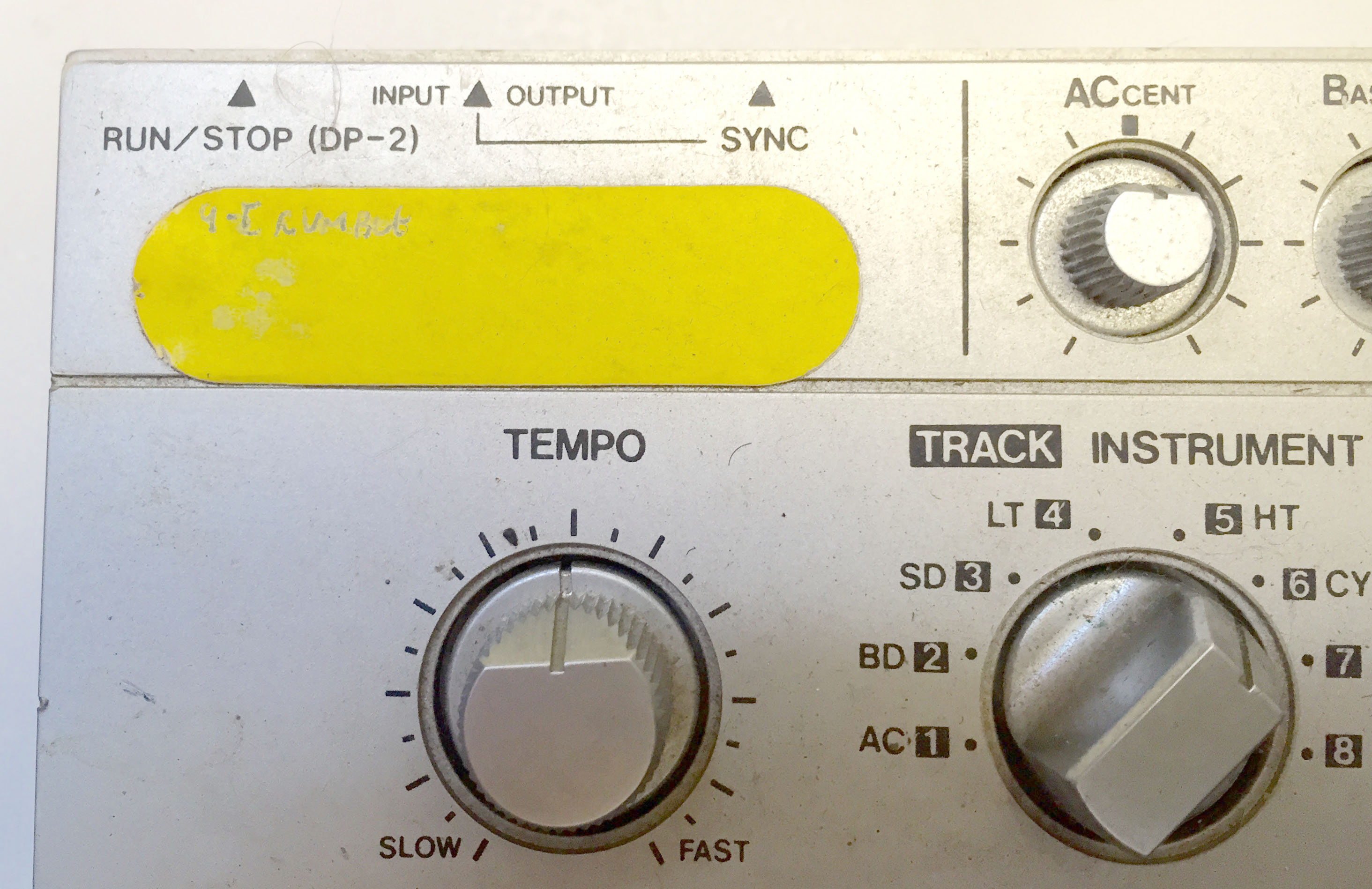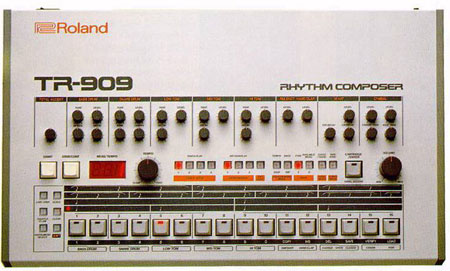|
Roland MC-303
The Roland MC-303 is the first of a series of musical instruments known as a Groovebox. It combines a simple sound module with a sequencer to record and store notation, along with controls aimed at encouraging the musician to improvise the music while it is playing. Despite the number in its name and the attention it received at its launch, the MC-303 has more in common with other MC prefixed synthesizers (such as the Roland MC-202), which contain built-in sequencers, than it does with the famous Roland TB-303. As the first Groovebox, the MC-303 was the first in a line of inexpensive products specifically targeted towards house DJs and amateur home musicians rather than professional producers. It was superseded by the Roland MC-505. It is the predecessor to the Roland JX-305, Roland D2, Roland MC-307, Roland EG-101, Roland MC-09, Roland MC-909, Roland MC-808, and most recently the Roland MC-707 in 2019, along with its more portable sibling, the Roland MC-101. Features The key f ... [...More Info...] [...Related Items...] OR: [Wikipedia] [Google] [Baidu] |
Roland Corporation
is a Japanese manufacturer of electronic musical instruments, electronic equipment, and software. It was founded by Ikutaro Kakehashi in Osaka on 18 April 1972. In 2005, its headquarters relocated to Hamamatsu in Shizuoka Prefecture. It has factories in Malaysia, Taiwan, Japan, and the United States. As of 31 March 2010, it employed 2,699 people. In 2014, it was subject to a management buyout by its CEO, Junichi Miki, supported by Taiyo Pacific Partners. Roland has manufactured numerous instruments that have had lasting impacts on music, such as the Juno-106 synthesizer, TB-303 bass synthesizer, and TR-808 and TR-909 drum machines. It was also instrumental in the development of MIDI, a standardized means of synchronizing electronic instruments manufactured by different companies. In 2016, ''Fact'' wrote that Roland had arguably had more influence on electronic music than any other company. History 1970s Having created Ace Electronic Industries Inc in 1960, Ikutaro Kakeh ... [...More Info...] [...Related Items...] OR: [Wikipedia] [Google] [Baidu] |
Roland MC-09
The Roland MC-09 "PhraseLab" is a Roland synthesizer, described as a Roland TB-303 emulator featuring an effects processor and a 4-part phrase sampler. Features The key features of the MC-09 are: * Single DSP monosynth for bass (TB-303 emulator), lead and drums * Pattern sequencer for up to two measures with 16 beat per measure resolution * Four track audio looper, samples patterns or internal input as "phrases" * Loop control function, allows sampling phrases with varying pitch or chopping and rearranging phrases * Effect processor (exclusive with monosynth) * Smartmedia storage * MIDI MIDI (; Musical Instrument Digital Interface) is a technical standard that describes a communications protocol, digital interface, and electrical connectors that connect a wide variety of electronic musical instruments, computers, and re ... in and out connections (but no MIDI thru) References MC-09 PDF Documentation Links: Roland MC-09 Owner's ManualRoland MC-09 MIDI Implementat ... [...More Info...] [...Related Items...] OR: [Wikipedia] [Google] [Baidu] |
Roland TR-808
The Roland TR-808 Rhythm Composer, commonly known as the 808, is a drum machine manufactured by the Roland Corporation between 1980 and 1983. It was one of the first drum machines to allow users to program rhythms instead of using preset patterns. Unlike its nearest competitor at the time, the more expensive Linn LM-1, the 808 generates sounds using analog synthesis rather than by playing samples (prerecorded sounds). Launched when electronic music had yet to become mainstream, the 808 received mixed reviews for its unrealistic drum sounds and was a commercial failure. After building approximately 12,000 units, Roland discontinued the 808 after its semiconductors became impossible to restock. It was succeeded by the TR-909 in 1983. Over the course of the 1980s, the 808 attracted a cult following among underground musicians for its affordability on the used market, ease of use and idiosyncratic sounds, particularly its deep, booming bass drum. It became a cornerstone of the e ... [...More Info...] [...Related Items...] OR: [Wikipedia] [Google] [Baidu] |
TR-909
The Roland TR-909 Rhythm Composer is a drum machine introduced by Roland Corporation in 1983, succeeding the TR-808. It was the first Roland drum machine to use samples for some sounds, and the first with MIDI functionality, allowing it to synchronize with other devices. Though it was a commercial failure, the 909 became influential in the development of electronic dance music genres such as techno, house and acid. Design The 909 was designed by Tadao Kikumoto, who also designed the Roland TB-303 synthesizer. Chief Roland engineer Makoto Muroi credited the design of the analog and pulse-code modulation voice circuits to "Mr Ou" and its software to "Mr Hoshiai". Whereas its predecessor, the TR-808, is known for its "boomy" bass, the 909 sounds aggressive and "punchy". It was the first Roland drum machine to use samples (prerecorded sounds), for its crash, ride and hi-hat sounds; other sounds are generated with analog synthesis. As the clap and snare are generated via the ... [...More Info...] [...Related Items...] OR: [Wikipedia] [Google] [Baidu] |
TR-606
The Roland TR-606 Drumatix is a drum machine built by the Roland Corporation from 1981 to 1984. It was originally designed to be used with the Roland TB-303, a monophonic analog bass synthesizer, to provide a simple drum and bass accompaniment to guitarists without backing bands. History The TB-303 and TR-606 launched in 1981 as a matched pair to provide solo artists the chance to practice without other individuals, solely using the TR-606 and TB-303 as drums and bass lines to practice to, but the programming and artificial sounds made the boxes uncomfortable to use and they soon lost their luster. The group was doomed to an early demise as popular music soon shifted to sampled drum sounds and real bass lines for hit songs, as sample capabilities were the newest development of the late 1980s. At one time, the TR-606 could be found in pawn shops for as little as US$50; since the resurgence in popularity of analog drum sounds for electronic music, however, the TR-606 will commonly ... [...More Info...] [...Related Items...] OR: [Wikipedia] [Google] [Baidu] |
Roland CR-78
The Roland CompuRhythm CR-78 is a drum machine launched in 1978. Although primitive by later standards, the CR-78 represented an important advance in drum machine technology at the time, in particular by allowing users to program and store their own drum patterns. The wood effect cabinet and preset rhythms of the CR-78 such as ''Waltz'', ''Bossa Nova'' and ''Rhumba'' suggest that it was seen by its designers as primarily an accompaniment for an electric organ, but the CR-78 became one of the favorite instruments of pop and electronic musicians in the late 1970s and early 1980s. It was used by artists including Phil Collins, Peter Gabriel, Daryl Hall & John Oates, Blondie, Ultravox, Genesis, John Foxx, Orchestral Manoeuvres in the Dark, Roxy Music, and Gary Numan. Operation The CR-78 uses analog drum voices that sound very little like real percussion instruments. The unit also incorporates an NEC microprocessor CPU (NEC) uPD8048C-015 8-bits to provide digital cont ... [...More Info...] [...Related Items...] OR: [Wikipedia] [Google] [Baidu] |
Preset
Preset may refer to: * Default (computer science), a setting or value automatically assigned to a software application, computer program, ''etc''. * Preset (electronics), a variable component on a device only accessible to manufacturing or maintenance personnel * Pre-programmed setting on various electronic products and musical instruments, including: ** Combination action on pipe organ ** Preset button (tuner) - station selectors on the tuner of radio receiver and television set ** Preset key (Hammond organ) - inverse color keys on Hammond organs, to recall pre-programmed tonewheel settings ** Preset rhythm - pre-programmed rhythm-pattern on drum machine ** Synthesizer patch stored a pre-programmed tone ;Mathematics * Pre-ordered set * A set without an equivalence relation; see ;Music * The Presets The Presets are an Australian electronic music duo of Julian Hamilton (vocals, keyboards) and Kim Moyes (drums, keyboards). Formed in 2003 and signed to Modular Recordings, ... [...More Info...] [...Related Items...] OR: [Wikipedia] [Google] [Baidu] |
Timbrality
Monotimbral (from the root prefix ''mono'' meaning one, and ''timbre'' meaning a specific tone of a sound independent of its pitch) is usually used in reference to electronic synthesizers which can produce a single timbre at a given pitch when pressing one key (if the synth is monophonic) or multiple keys (if the synth is polyphonic). An electronic musical instrument may be multitimbral, which means it can produce two or more ''timbres'' (also called ''sounds'' or ''patches'') at the same time. Instruments which may be multitimbral include synthesizers, samplers, and music workstations. A multitimbral instrument might be configurable in a variety of ways: *Splitting the keyboard at a given point allows a musician to play, for example, a bass guitar sound with the left hand and a piano sound with the right hand. *Layering timbres allows a musician to play, for example, a pipe organ sound and a string ensemble sound together. *Combinations of keyboard splits and layers may be possib ... [...More Info...] [...Related Items...] OR: [Wikipedia] [Google] [Baidu] |
Roland Corporation
is a Japanese manufacturer of electronic musical instruments, electronic equipment, and software. It was founded by Ikutaro Kakehashi in Osaka on 18 April 1972. In 2005, its headquarters relocated to Hamamatsu in Shizuoka Prefecture. It has factories in Malaysia, Taiwan, Japan, and the United States. As of 31 March 2010, it employed 2,699 people. In 2014, it was subject to a management buyout by its CEO, Junichi Miki, supported by Taiyo Pacific Partners. Roland has manufactured numerous instruments that have had lasting impacts on music, such as the Juno-106 synthesizer, TB-303 bass synthesizer, and TR-808 and TR-909 drum machines. It was also instrumental in the development of MIDI, a standardized means of synchronizing electronic instruments manufactured by different companies. In 2016, ''Fact'' wrote that Roland had arguably had more influence on electronic music than any other company. History 1970s Having created Ace Electronic Industries Inc in 1960, Ikutaro Kakeh ... [...More Info...] [...Related Items...] OR: [Wikipedia] [Google] [Baidu] |
Polyphony
Polyphony ( ) is a type of musical texture consisting of two or more simultaneous lines of independent melody, as opposed to a musical texture with just one voice, monophony, or a texture with one dominant melodic voice accompanied by chords, homophony. Within the context of the Western musical tradition, the term ''polyphony'' is usually used to refer to music of the late Middle Ages and Renaissance. Baroque forms such as fugue, which might be called polyphonic, are usually described instead as contrapuntal. Also, as opposed to the ''species'' terminology of counterpoint, polyphony was generally either "pitch-against-pitch" / "point-against-point" or "sustained-pitch" in one part with melismas of varying lengths in another. In all cases the conception was probably what Margaret Bent (1999) calls "dyadic counterpoint", with each part being written generally against one other part, with all parts modified if needed in the end. This point-against-point conception is opposed to " ... [...More Info...] [...Related Items...] OR: [Wikipedia] [Google] [Baidu] |
Speech Synthesis
Speech synthesis is the artificial production of human speech. A computer system used for this purpose is called a speech synthesizer, and can be implemented in software or hardware products. A text-to-speech (TTS) system converts normal language text into speech; other systems render symbolic linguistic representations like phonetic transcriptions into speech. The reverse process is speech recognition. Synthesized speech can be created by concatenating pieces of recorded speech that are stored in a database. Systems differ in the size of the stored speech units; a system that stores phones or diphones provides the largest output range, but may lack clarity. For specific usage domains, the storage of entire words or sentences allows for high-quality output. Alternatively, a synthesizer can incorporate a model of the vocal tract and other human voice characteristics to create a completely "synthetic" voice output. The quality of a speech synthesizer is judged by its similarity to ... [...More Info...] [...Related Items...] OR: [Wikipedia] [Google] [Baidu] |


